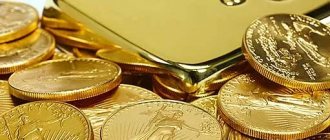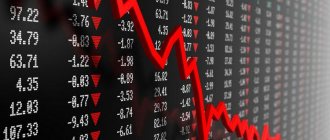All about gold Post updated: May 27, 2020
Gold is rightfully considered one of the important elements of the global financial system, since it has many areas of application, and its reserves are not unlimited. Over the centuries, this material has not disappeared from the earth; it has been melted down, processed and accumulated. Today, bank gold reserves amount to more than 30 tons of gold. The gold rate is constantly changing and in order for its movement to be traced, a quote chart is compiled and archived.
Price quotes over the past few years show that gold is a fairly serious type of investment. Excessive fuss is not suitable for him, so a speculative strategy does not work here. Experienced investors prefer long-term investing.
The advantage of gold deposits is that in this way you can save money even with huge inflation. To invest in precious metals, it is important to know price movements. A chart of changes in the value of gold can help you find out the cost of the metal online, because gold prices are constantly changing.
Change in gold rate for the year (USD/1 troy ounce, London fixing):
The prospect of rising prices worries any investor. Knowledge of price movements can be useful in order to purchase large quantities of gold at low prices. Investing in gold requires a clear plan of action. To make a profit, you need to constantly monitor price dynamics. You can always trace how the gold rate has changed over a year or over decades, for which you can use a chart.
The state of affairs on the world market, which reacts to the political and economic situation in the world, contributes to the dynamics of prices for precious metals.
Having analyzed how the gold price chart changed over the year, you can see that gold in the short term turned out to be not the most profitable investment, but over several decades, quotes for the same metal have increased more than 30 times. Thus, for long-term investments, gold remains the leader in terms of investment benefits.
- World gold market
- World gold prices
- Seasonal fluctuations in gold prices
- Gold sample price
- Forecasts for the future
World gold market
The world market is the extraction, distribution and consumption of gold. The gold market has some features:
- Almost all countries have insurance and reserve gold funds;
- Countries' registered gold reserves can be put on the market at any time;
- The population has a significant amount of gold in the form of jewelry.
Gold mining significantly influences the formation of its prices.
Gold mining companies influence the formation of prices. International banks can also influence quotes, persuading miners to streamline or reduce sales volumes.
World gold prices
The first jump in gold prices was associated with the beginning of World War II. Before this, the actual quotation established in 1717 for a troy ounce of gold was in effect without changes. Then there was a period of stability until the gold standard was abolished in 1971. After this, the rapid rise in gold prices was followed by a long decline.
You should pay attention to price changes in order to profitably buy gold from the bank. If you look at the gold rate for a month, the graph will show minor price fluctuations, so you should consider long-term periods.
The abandonment of gold backing of national currencies led to an increase in the volume of paper money and inflation in most countries. World leaders realized that ending the gold standard only increased economic problems. Due to the decline in production and inflation in many countries, gold prices have skyrocketed like never before.
In the new millennium, prices actively soared.
The fight against inflation has begun. The authorities reduced the issue of paper money. This helped significantly reduce gold prices. The gold rate chart will help you track this process online.
Thus, it was possible to stabilize the cost of the precious material for several years. Since 2002, prices began to rise again. The reason is another increase in the amount of paper money.
If you trace the price of gold over the past ten years, the dynamics that the graph displays proves that during this time the cost of the metal has increased significantly. Experts believe that this is just the beginning and prices will continue to rise.
In times of crisis, investors prefer to invest in gold, thereby increasing its value.
One of the reasons for the growth was the events of September 11, 2001 and the decline in prices for mortgage loans in the United States. The boom in real estate purchases on credit ended with an economic crisis around the world.
A Brief 2000-Year History of Gold Prices
Posted by Stephen Simpson
It will not be an exaggeration to say that humanity has valued gold since it learned to mine it. In the burial grounds of the 4th millennium BC. There were elaborate gold artifacts, and gold weights were used in trade long before the Lydians began casting coins in the 6th century. BC.
It is wrong to think that gold has been flat all this time. Inflation is by no means a modern concept, and gold prices have been surprisingly volatile throughout history. This is partly due to its rarity, with 171,000 tonnes of gold mined throughout human history (by comparison, Brazilian iron ore miner Vale mined 323 million tonnes in 2011 alone). Thus, economies that grew or contracted always found themselves chasing a relatively small (and for long periods of time, often almost constant) supply of gold.
Antiquity
By definition, it is difficult to translate the ancient value of gold and silver into modern concepts, since the circumstances were very complex. Many records and sources discussing prices explain them in terms of paying legionnaires and slaves - and this is very difficult to reconcile with modern realities. However, several attempts can be made in determining the value of gold.
The Greek gold "talent" weighed about 26 kg, or 829 troy ounces - an amount worth about $1.4 million today. The silver talent is the salary of a professional specialist for 9 years, and the gold talent could be the payment for 270 years of similar work. At current rates of $20 an hour, that would cost about $13.5 million.
As another example: in the 5th century. a worker earned about 1 drachma, or 0.004 troy ounces of gold (about $8 in modern terms). By 377 BC, the payment had risen to two and a half drachmas ($20). A small clarification: ancient sources indicate that in the 5th century. One drachma could buy 3 kg of olive oil - about the same as $9-10 today.
While the Romans took record keeping to new heights, it is still too problematic to translate prices into modern equivalents. Despite this, there are some guidelines. Craftsman in Rome in the 1st century. BC. could earn 12 asses a day - that's about 4 grams of silver, or about $4.
The Romans also seem to have started inflation and falsification. Augustus established the gold standard in 30 BC, but it only lasted about 100 years. Nero reduced the weight of the dinar by 4% and the silver content by approximately 5% (to 93.5%), and after 200 years the dinar was only 40% silver. From the beginning to the end of the 2nd century. a “measure” of wheat rose in price from 7-8 drachmas (historians often convert dinars to drachmas) to 120,000. Likewise, Emperor Diocletian tried to fix the price of 1 pound of gold at 50,000 dinars in 301 AD, but by 324 AD. the exchange rate rose to 300,000 to one pound, and by the middle of the 4th century. – up to 2.1 billion per pound.
Middle Ages
After the ancient and classical periods, inflation continued on an unsustainable path as rulers devalued currencies (effectively inflating the economy) to pay for wars, while large-scale population declines resulting from wars and disease often created strong deflationary pressures.
There are a few stories worth mentioning here. When (African ruler) Mansa Musa made his famous pilgrimage to Mecca in 1324, his entourage was said to have carried some 32,000 pounds of gold. Mansa Musa was so extravagant that he alone raised the price level in Cairo, Medina and Mecca for years to come, changing the price of gold by 12% in Cairo.
Present tense
While some governments adapted inferior gold standards during World War I to finance armies through inflation, gold prices remained remarkably stable in the early 20th century, despite the chaos and carnage of two world wars. From $18.92 in 1910, gold rose in price to $20.68 in 1920, to $20.65 in 1930, and to $33.85 in 1940. After World War II, gold, which was spent for most of the next quarter century, was exchanged for approximately $35.
Since 1968, the fixed gold standard began to disintegrate. It was then that a two-tier system was introduced, allowing gold to be circulated in private trade, but maintaining a fixed price for central banks. Central banks (especially in the US) could not afford to maintain this rate, and the fixed system completely collapsed in 1971.
Prices responded quickly. Since 1967, gold has risen in price from $34.95 an ounce to $39.31 in 1968, to $40.62 in 1971, and to $154 in 1974. Gold prices peaked at $800 an ounce in 1980, before retreating to the $300s for much of the 1980s and 1990s. After falling to $275 an ounce in 2001, gold has risen sharply over the course of a decade, settling today at around $1,700 an ounce.
It is worth recalling the circumstances under which price increases occurred: Henry Ford revolutionized American industry by raising workers' wages to $5 a day in 1914 (a little more than a quarter of an ounce of gold). Today, with the official minimum wage of $7.25, a day's work would pay $58, or only about 3% of an ounce of gold. While this is not an entirely fair comparison, as Ford's wages were well above the average for the time—the average wage for a mechanic worker was about $2.34 per day—it does demonstrate how the price of gold can change significantly over relatively short periods. time.
Future
The history of gold value and price is a history of predictable unpredictability. Given the current state of affairs, it is difficult to imagine that states will abandon pro-inflationary policies that significantly depreciate the value of money. At the same time, the supply of gold is unlikely to increase significantly, which suggests a further increase in its price. Likewise, a revolution in the economy usually occurs without much warning, and a return to tighter monetary policy could significantly reduce the value of gold at some point in the future.
Seasonal fluctuations in gold prices
There are also annual fluctuations in gold prices, which do not depend on the economic and political situation in the world.
You should not buy gold before major holidays. They influence the pricing of precious metals. Usually, prices rise at this time.
The price of gold is affected by demand, the discovery of new gold deposits and mining methods, and the amount of costs for their exploration.
The price of precious metals is quite dependent on the stock market.
The position of stock markets also influences price fluctuations. When stock indices rise, the price of gold falls, which is well reflected in the graph that can be tracked online at the beginning of our article. This happens because investors invest their money in stocks and other securities. When a crisis hits, most people prefer more conservative investments like gold.
Gold mining companies may, based on their own interests, reduce the amount of gold they produce, which can cause prices to skyrocket.
Gold investment strategy
In summarizing the features of gold as a generally recognized and liquid asset, it is important to take into account a number of points.
Often, the main profitability on transactions with precious metals is formed not by the interest rate, but by the increase in the cost of such a product.
At the same time, the trend can be very accelerated against the backdrop of favorable factors. If this does not happen, a moderate increase in the exchange rate will occur gradually. For this reason, investors are advised to choose gold to work primarily on long-term strategies. To protect against sudden market drawdowns, it is necessary to monitor current data on the state of gold production and demand for it.
Gold sample price
In any piece of jewelry, the price depends on the amount of pure gold (fine gold) it contains. The sample for the jewelry is “assigned” to a special assay committee. In different countries, the hallmark has its own differences.
There are dozens of gold samples in the world. Of the alloy rating systems, two of them are used: metric and carat. The metric test is considered more convenient and accurate. This test shows how many milligrams of pure gold are in 1 gram of alloy. Many countries measure the gold content of items in karats.
375 standard is the cheapest.
The lowest is 375 standard. In addition to gold, a product of this standard contains alloys of copper, palladium and silver, which improve the characteristics of the product, making it stronger and more stable.
Some people consider gold to be a not very useful metal, which is only suitable for making jewelry. But a large number of useful properties indicate the opposite. Every year new directions for the use of precious metal are opening up.
Gold rate for today
The main benefit of investing in gold is that this method of investment makes it possible to preserve your finances even during a period of serious economic crisis and high inflation in the country. You can find out the cost of one gram of bank gold on a specific day on the official website of the Central Bank of the Russian Federation. On average, at the moment the rate fluctuates and is about 1320 rubles per 1 gram (information as of the beginning of July 2021). Price dynamics largely depend on what the situation will be on the global gold market. The course is quite “sensitive” to various kinds of economic and political changes in events taking place on the world stage.
Forecasts for the future
The current chart shows that the rapid rise in gold prices is followed by a protracted decline. Experts are confident that a drop in prices can be seen in the near future, but not everyone agrees with this and expect different prices for gold in the near future.
Most experts believe that the collapse of the gold market depends on the United States. As long as they do not refuse to increase the money supply, nothing threatens gold. Despite the arguments of politicians, a well-functioning system allows problems to be transferred to other countries of the world through the dollar, which affects the situation on the market.
There are some common factors that can stop gold prices from rising. These reasons include: the possibility of problems in the euro area, the behavior of central banks of leading countries, which largely depends on the political situation.
Virtually every expert has different forecasts for price fluctuations. What the price of gold will be today can be predicted by the price chart over the past few years. It is known for sure that the banking gold market can satisfy any needs. Buying lots of gold is suitable both for saving the family budget and for large capital.
Seasonality
The exchange rate, as is known, is determined by two factors that depend on each other. It's about supply and demand. With precious metals, things are a little different. If you analyze the price chart for gold, annual periods when there is an increase and decrease in the price level for the precious metal become obvious.
Demand for the precious metal definitely depends on calendar holidays. For example, when the marriage season begins in India, prices for gold jewelry immediately increase. Sales of products in America also increase significantly during the Christmas and Thanksgiving holidays. Another increase is expected at the onset of the New Year.
As a result, we can note the following trends in gold price fluctuations according to the chart for the year from 2005 to 2015:
- second half of October – first half of February – growth;
- March – May – another significant increase, but smaller;
- the first half of August - the first half of October - the increase in prices, as a rule, is slightly higher than in the previous period.
According to Russian legislation, transactions for the purchase and sale of gold and other precious metals are carried out at negotiated prices. This means that any Russian bank has the right to set its own price conditions.
For example, Sberbank, like other market participants, bases its figures on data from the Central Bank, as well as the fixing of the London Stock Exchange.
At Sberbank, the exchange rate in rubles for precious metals depends on the following factors:
- change in demand;
- cost of banking services;
- regional variations;
- bank profit;
- other factors.
Accordingly, the higher the value of these parameters, the higher the rate will be. Of course, for Sberbank, with its developed structure, the regional factor is of great importance. The difference in quotes in different branches (in different regions) can vary by up to 10 percent.
In addition, depending on the location of the Sberbank branch, profit is also included, which generally significantly affects the price difference. The cost is fixed every day, and the data is immediately displayed on the bank’s official website.
Let's not forget that the cost of gold in Sberbank is also determined by the form of acquisition of this precious metal:
- ingot;
- metal bill;
- coins.
In rubles, bars are more expensive than other options, and coins will cost about the same, but in the end they will cost more, taking into account the peculiarities of taxation. After all, you will have to pay 18% VAT. The total cost will include this amount. If an account is opened, then there is no actual purchase of gold; there is only a link to the quotes for this precious metal.
Let's summarize
As you can see, the chart of changes in gold prices is a dynamic indicator, which over the course of several years is constantly growing. Therefore, you can make long-term investments in rubles, for example, even in 2015, realizing that in a few years the investment will bring good income, especially if the investment amount is considerable. And don’t panic if there is a drop in value. This trend has been typical for many years. However, practice shows that some time will pass, there will definitely be a jump caused by some events in the world: a crisis, a disaster, political statements or actions, and so on. Therefore, you just need to wait for the benefits.










